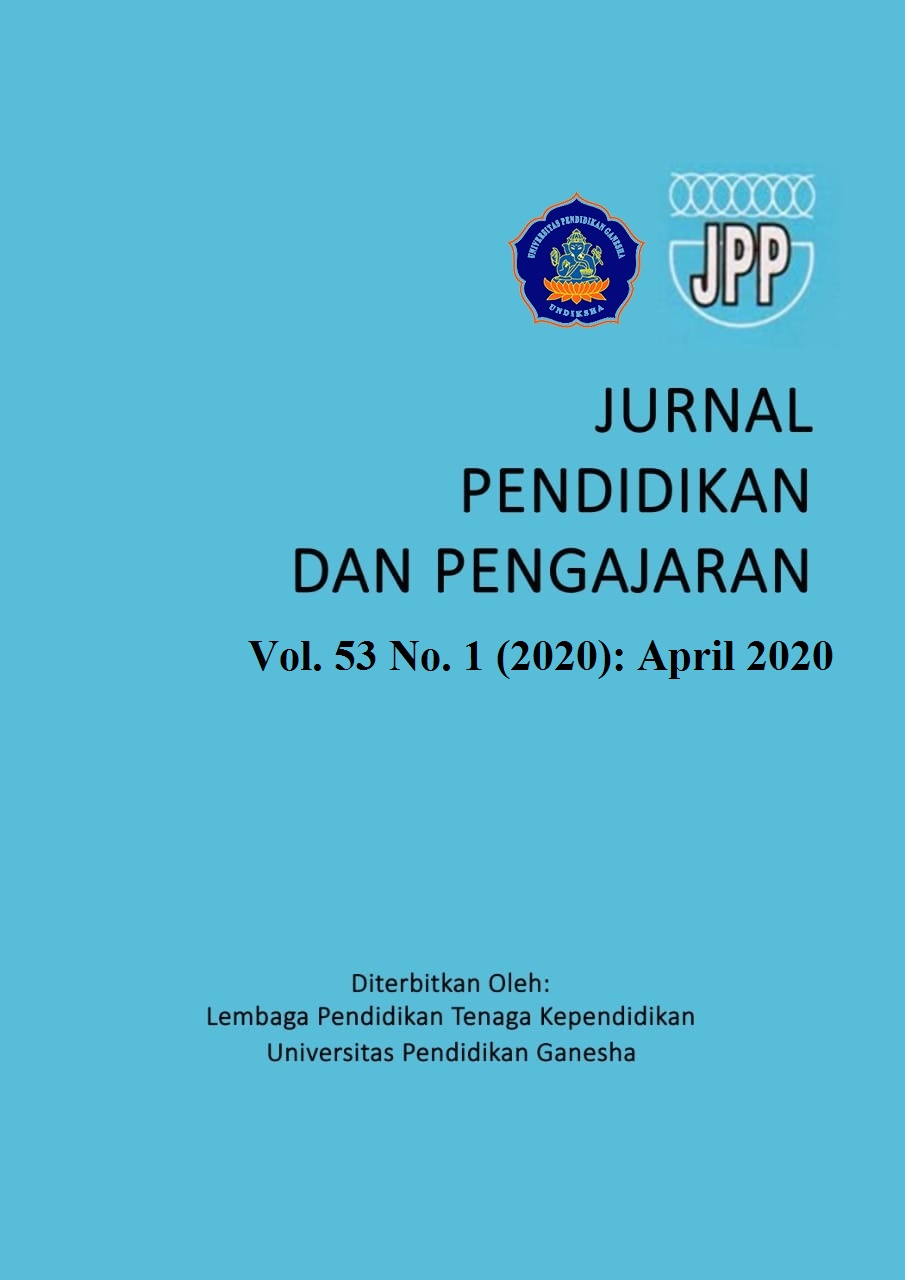The Positive Effect of Creative Movement Model on Children’s Personal Skills
DOI:
https://doi.org/10.23887/jpp.v53i1.24699Keywords:
model, creative movement, personal skills, early childhoodAbstract
As the importance of personal skills stimulation for children to prepare and equip children in facing various learning levels of further education is necessary, research about it is needed. This study examined the effect of creative movement model on the personal skills of early childhood. This study used a quasi-experimental approach with post-test only control group design. The population of this study was students of Group B Cluster III Kindergarten in Payangan District, Gianyar which the sample was Melati Kindergarten as an experimental group with treatment and Hindu Widya Kumara Santhi Kindergarten as a control group without treatment. Data analysis of the study was descriptive statistics and inferential statistics, by using t-test that was processed by IBM SPSS Statistics ver. 24 for Windows. The result of data interpretation in hypothesis test showed that Sig. (2-tailed) score was 0.001 which meant the significance score was smaller than α (0.001 <0.05). According to these statements, it could be concluded that Ho was rejected and Ha was accepted. The study demonstrates that creative movement model has positive effect on children’s personal skills. With this finding, parents and especially educators expected to be willing to develop various creative movement activities that can stimulate children's personal skills more optimally and sustainably. The benchmarks of children's achievement should go beyond cognitive aspects; thus, teachers need to provide stimulation for children's personal skills to develop social emotional aspect.
References
Antara, P.A. 2015. Analisis Gerak Kreatif Dan Bakat Seni Dalam Menstimulasi Kemampuan Spasial Anak (Studi Pada Kelompok B Taman Kanak-Kanak Di Kecamatan Blahbatuh, Kabupaten Gianyar, Propinsi Bali). Hal 45-58
Antara, P. A. 2018. Stimulasi Metode Permainan Kreatif Berdesain Creative Movement Dalam Menumbuhkan Kemampuan Spasial Anak Dengan Mempertimbangkan Budi Pekerti. 12 (November), 301–310.
Catron, E. Carol & Jan Allen. 1999. Early Childhood Curriculum A Creative-Play Model Second Edition. Nj: Merril Prentice Hall.
Dantes, N. 2012. Analisis Dan Desain Eksperimen. Singaraja: Program Pasca Sarjana Undiksha.
Dow, C. B. 2010. The Power of Creative Dance. In Performing Arts: Music,Dance, and Theater in the Early Years (Issue 2 March, pp. 31–33).
Gallahue, David L. And John C. Ozmun. 1998. Understanding Motor Development. Usa: The Mcgraw-Hill Companies.
Hawkins, A. M. 2003. Bergerak Menurut Kata Hati. Metode Baru Dalam Menciptakan Tari, Diterjemahkan Oleh I Wayan Dibia, Jakarta: Ford Foaundation Dan Masyarakat Seni Indonesia.
Hermayanti, T.2015. Peningkatan Kepercayaan Diri Melalui Tari Kreatif. 389–400.
Hidayat, A., & Darma, U. B. (2017). Peningkatan aktivitas gerak lokomotor, nonlokomotor dan manipulatif menggunakan model permainan pada siswa sekolah dasar. Pendidikan Jasmani Dan Olahraga, 2(September), 21–29.
Hurlock, E. B. 1978. Perkembangan Anak, Jilid 2. Alih Bahasa Meitasari Tjandrasa. Jakarta: Erlangga
Kostelnik, M.J., Soderman, A.K., Dan Whiren, A.P. 1999. Developmentally Appropriate Curricullum, Best Practices in Early Childhood Education. New Jersey: Prentice Hall.
Kusumaastuti, Eny. 2014. Penerapan Model Pembelajaran Seni Tari Terpadu Pada Anak Sekolah Dasar. Mimbar Sekolah Dasar. Volume 1 Nomor 1. 44-56
Laban Rudolf. 1988. Modern Education Dance. London: Mac Donald and Evans.
Lazarus, R.S.1991. Emotion in Adaptation. New York: Oxford University Press.
Mashar, Riana. 2011. Emosi Anak Usia Dini Dan Strategi Pengembangannya. Jakarta: Kencana.
Nugraha, Lesmana dkk. 2017. Penerapan Model Pendidikan Gerak Dalam Mengembangkan Pola Gerak Dasar Manipulatif Melalui Kerangka Analisis Gerak (Movement Anvlysis Framework) Vol. 2, No. 2. Hal 22-56
Olivia, G. 2014. Education to Theatricality : Creative Movement as a Training Model. Global Journal Od Human Social Science : G Linguistics and Education, 14(9), 1–18.
Papalia, D.E., Olds, S.W., and Feldman, R.D. 2002. Child’s World, Infancy Through Adolences. Ninth Edition. Boston: Mcgraw-Hill.
Skoning, S. N. (2008). Movement and Dance in the Inclusive Classroom Movement and Dance in the Inclusive Classroom. TEACHING Exceptional Children Plus, 4(6).
Smith, J. (2003). Dance Composition. A Practical Guid For Teacher. Surrey: Unwin Brothers Ltd.
Sriningsih, N. (2010). Program Pengembangan Kecakapa Pribadi (Personal Skills) di TK. Cakrawala Pendidikan, 2(2), 1–10.
Sugiyono. 2009. Metode Penelitian Kuantitatif Dan Kualitatif Dan R & D. Bandung: Alfabeta.
Summers, J., Larkin, D., & Dewey, D. 2008. Activities of daily living in children with developmental coordination disorder : Dressing , personal hygiene , and eating skills. Human Movement Science, 27(1), 215–229. https://doi.org/10.1016/j.humov .2008 .02.002
Yusria. 2016. Peningkatan Kecakapan Personal Melalui Pembelajaran Kontekstual. Jurnal Pendidikan Anak Usia Dini, 10(2), 327–348. https://doi.org/https://doi.org/10.21009 /JPUD.102
Downloads
Published
How to Cite
Issue
Section
License
Authors who publish with Jurnal Pendidikan dan Pengajaran agree to the following terms:- Authors retain copyright and grant the journal the right of first publication with the work simultaneously licensed under a Creative Commons Attribution License (CC BY-SA 4.0) that allows others to share the work with an acknowledgment of the work's authorship and initial publication in this journal
- Authors are able to enter into separate, additional contractual arrangements for the non-exclusive distribution of the journal's published version of the work (e.g., post it to an institutional repository or publish it in a book), with an acknowledgment of its initial publication in this journal.
- Authors are permitted and encouraged to post their work online (e.g., in institutional repositories or on their website) prior to and during the submission process, as it can lead to productive exchanges, as well as earlier and greater citation of published work. (See The Effect of Open Access)





